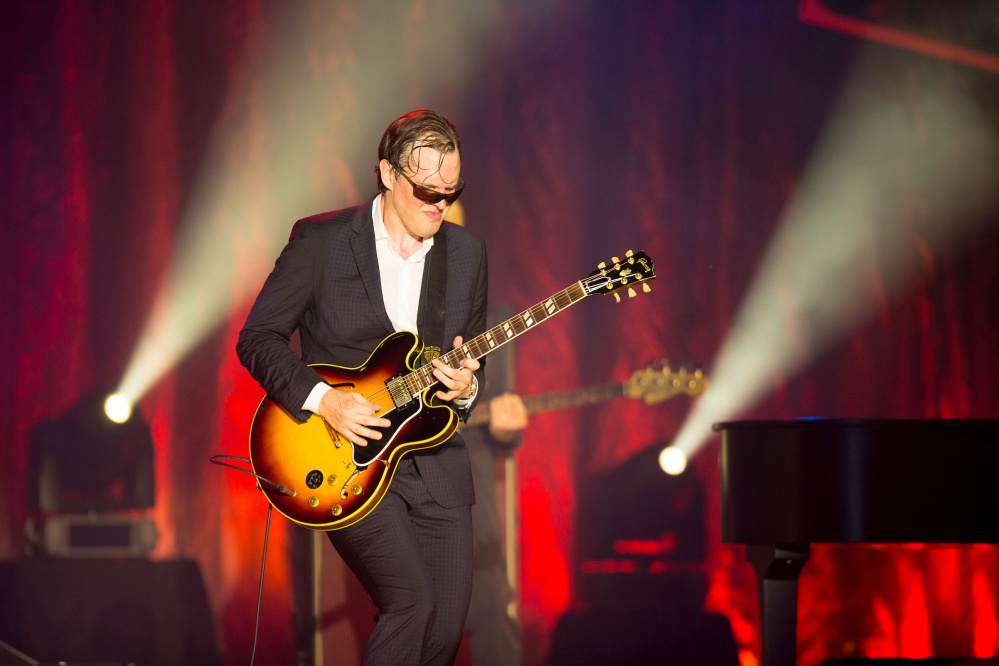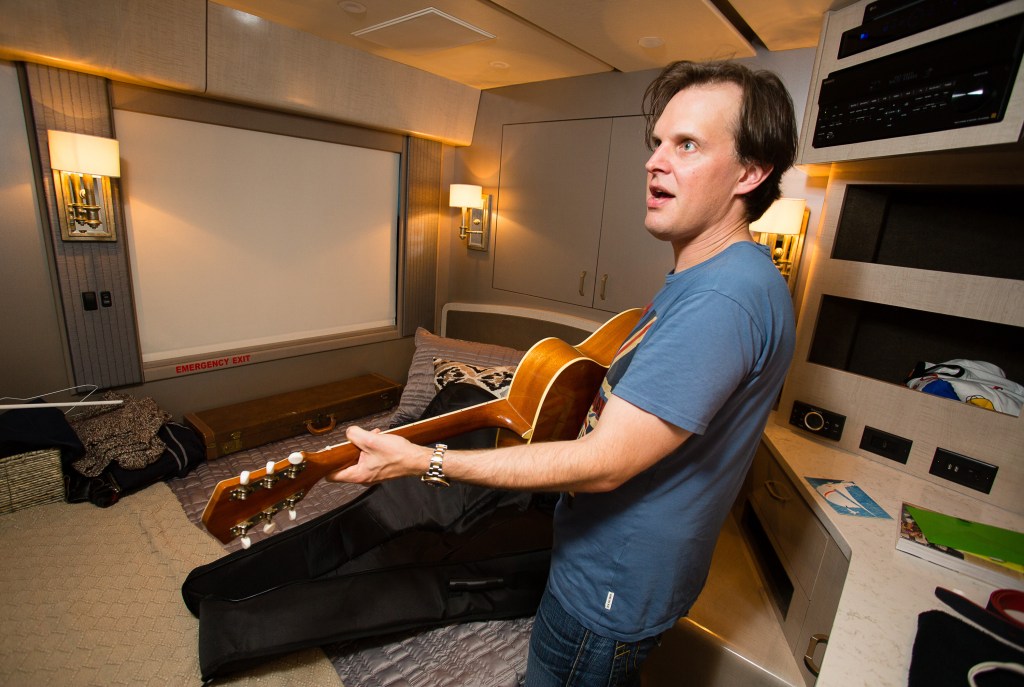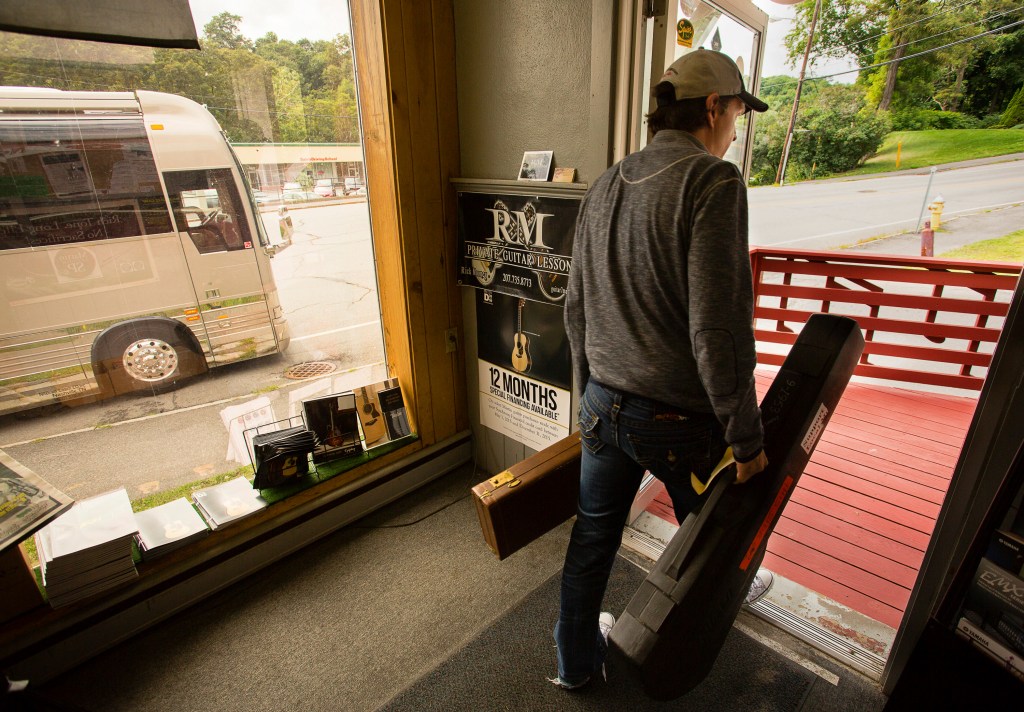LOS ANGELES — “It’s not a great time for music,” Joe Bonamassa says, his fingers reflexively rolling over the frets of an unplugged Gibson.
Now, try playing the blues. That’s Bonamassa’s music. It’s been a quarter-century since the last wave of blues guitar men – Stevie Ray Vaughan, Robert Cray and Jeff Healey – could ride the charts. Enter a pasty kid from central New York nicknamed “Smokin’ Joe” sometime around his 11th birthday.
Bonamassa, now 38, isn’t a great singer, he pumps out albums so regularly that you might wonder whether he’s paid by the lick, and sometimes, after the crowds go home, will slip out of his Hugo Boss suit for a pair of Simpsons jammies. But for those who care deeply about preserving the vital American music of B.B. King and Muddy Waters, Bonamassa may be the last, great hope.
He doesn’t look for crossover hits like Gary Clark Jr. He’s not as cool as Kenny Wayne Shepherd. From the outside, Bonamassa has managed to jump from clubs to theaters – including a pair of shows Thursday and Friday at Carnegie Hall (after appearing Jan. 16 at Merrill Auditorium in Portland). He’s also become a blues ambassador, hosting blues cruises, posing for guitar magazine covers and serving as a featured attraction during PBS pledge nights.
Bonamassa doesn’t gloat about his success.
“Truth be told, this thing is far bigger than I ever thought it would or anybody thought it would be,” he says.
Gary Bongiovanni, editor in chief of the concert trade publication Pollstar, notes that Bonamassa has managed to build a market that stretches beyond the United States.
“He might be flying under the radar, but he is a worldwide attraction,” Bongiovanni says. “When you have talent, eventually that does show through and Joe Bonamassa’s a real player.”
Under the radar? Not even some of the musicians in Bonamassa’s band realized what they were getting into.
“When I started playing with him, we sold out everywhere we played,” says keyboardist Reese Wynans, a member of Steve Ray Vaughan and Double Trouble in the 1980s. “I was also a little shocked he had, like, 16 records out.”
HE WAS JUST 13 when the TV cameras followed him through the school halls.
Jane Pauley introduced “Smokin’ Joe” to America on that 1991 episode of “Real Life.” The kid fumbles with his papers at his locker, picks up a pile of clothes in his room and, naturally, shreds his way through a rehearsal in the family basement. B.B. King and John Lee Hooker, in interviews aired in the piece, talk of how this kid is special.
“He would sit in his room for hours and just play,” remembers Deb Bonamassa, his mother, who spent much of her time driving the boy to gigs in the family’s ’88 Pontiac Bonneville. “We used to yell at him to go out.”
His father, Len, an amateur guitarist, introduced him to the blues early on. He started playing at age 4. By his teenage years, Bonamassa knew he was out of touch with popular music.
“Kids were into Van Halen, Bon Jovi, Def Leppard,” he says. “My grade-school crush had a Europe shirt. I used to watch MTV when they played music and discovered Robert Cray, Stevie Ray Vaughan, Jeff Healey.”
By his senior year, Bonamassa had graduated from basement jams to a band called Bloodline, made up of the sons of famous (Miles Davis) and semi-famous (Robbie Krieger and Berry Oakley) musicians. (He was the lone exception.) Bonamassa no longer went to class, getting tutoring on the road. Bloodline released its debut album in 1994 and then began to break apart.
“Joe, at 15, was strange,” says Berry Oakley Jr., the singer and bassist and son of the Allman Brothers Band founder. “We used to tease him. We would purposely find Penthouses and tape the nastiest pictures to his amp. He was mortified. All he did was music and play and play. It drove us nuts.”
It reached the point that Oakley and the other members voted to kick Bonamassa out. They felt that he didn’t appreciate their new songs and spent too much time soloing. Manager Roy Weisman listened and told them he agreed with the split. But he was sticking with Bonamassa.
“They were (expletive) spoiled brats who were lazy,” says Weisman. “All they wanted to do was nothing. Joe was a workaholic.”
There was a problem, though. Bonamassa played guitar. He’d never sung a lick and he didn’t write songs.
“Two weeks later, I get a cassette tape in the mail with a note saying, ‘Hey Roy, this is me trying to sing’ with a happy face, signed Joe. I pop it in my tape player. It was rough as hell but there were some vocal moments that were spectacular.”
TO UNDERSTAND HOW Joe Bonamassa builds his brand, don’t go see him on one of the countless nights he packs a theater. Go see him in Bangor, Maine, as he tries to see if he’s ready to make the leap into outdoor venues. After the gig, Bonamassa will say there were 3,000 people there, but that feels like a stretch. There’s enough open space on the lawn to land a helicopter. Compare that to the following night, when more than 15,000 people show up for Kenny Chesney.
But Bonamassa doesn’t mind. The summer gigs are a test. He and Weisman wanted to see if they were ready to take another step up. In the end, Weisman decided they weren’t. They lost money on two shows – in New Jersey and Salt Lake City – for the first time in a decade. That’s OK.
“I am the poster boy for brick-by-brick foundation building,” says Bonamassa. “Play a club. Put on a good show for 35 people. Come back. Build your market. Have people talk about you.”
This is how he and Weisman work. They tried major labels and also the William Morris Agency. Eventually, they realized they had to go it alone. Weisman knew the touring business well. His father, Eliot, had managed Frank Sinatra through his later years, when he was mostly a concert act. He also views himself as an outsider, based in Florida and not Los Angeles.
BACK IN 2006, Weisman started to tell the small clubs he wanted to charge more than the $12 a head that was typical. The bookers resisted.
So Weisman took a leap. He rented out the 2,500-seat Embassy Theatre in Fort Wayne, Indiana, and brought in just under 1,000 people. Less than half a house earned the pair a cool, $25,000 profit.
“We laughed our asses off,” says Weisman. “I don’t need to sell these places out. I just need to make money. From that point, we said, ‘you and me against the world.'”
The pair formed J & R Adventures, raised ticket prices, jacked up their marketing budget and agreed to any and all interviews, whether a glossy or an online newsletter. They made sure to record and release a steady flow of CDs and DVDs and, rather than keep the profits, reinvested in the business. They bought pages of ads in Guitar Player magazine and, before long, Bonamassa became a regular cover boy.
Of the two partners, Weisman tends to be brasher.
“I think Joe is definitely here to save the blues,” he says.
Bonamassa shrugs when he hears anybody call him the savior.
“When it’s all written and said and done, in 30 or 40 years, I think we’re going to get more credit for the business acumen than the music,” he says. “Nothing I’m doing musically is revolutionary in any way, shape or form.”
Guitars surround him, some so valuable they’re kept in a safe. He has several Les Paul Standards, the famous sunbursts known for their wood finish, in the bedroom of his tour bus. He keeps more at his house, which he playfully calls “Nerdville” or the “Bona-seum,” in Los Angeles’ Laurel Canyon neighborhood. Between the axes and his vintage amplifiers, Bonamassa estimates he’s spent as much as $4 million over the years on equipment.
“One of these days, when I get tired of it all, I’ll keep six guitars and the amps I’m using,” he says, “and I’ll have a big, old auction for charity. At the end of the day, I’d rather have this stuff than the money. I’ll tell you why. I sit here on my days off when I’m home surrounded by the things that I love.”
THE AFTERNOON BEFORE the Bangor show is free, so Bonamassa hops in one of his tour buses. They roll up to a small music store across from a grimy strip mall, and the guitarist, wearing jeans and a baseball cap, hops out to scour the inventory.
A few nervous fans spot him and approach. The store’s guitar tech shakes his hand, and within minutes, they’re geeking out over Bigsby vibratos, P-90 pickups and the pink, 1956 Gibson lap steel Bonamassa recently found. Then the guitarist eyes a 50-year-old Fender amp that may or may not be for sale.
“Dana, Joe Bonamassa’s here,” the tech is now saying into the phone to the store’s owner, who is not in at the moment. “He’s wondering about getting together.”
Bonamassa chews his gum anxiously.
“Ask him what he wants for the reverb unit,” he says, whispering to the tech.
In the end, there’s no deal. Bonamassa leaves his cellphone number and heads to the show.
Just before 8 p.m., he has changed into his suit. He walks through the parking lot behind the stage and passes one of his tour trucks. He paid to have his image and name painted on the side. “Best $7,000 I ever spent,” he says, before hopping on stage.
A Joe Bonamassa show is no improvised, 12-bar jam. It’s a throwback to when a blues show was a SHOW, a production, an event. When a fiery guitar player meets a stacked band, with backup singers in glittery gowns, horns and seasoned players such as Wynans and drummer Anton Fig, the longtime member of David Letterman’s “CBS Orchestra.”
Bonamassa plays the suave lead man. The dark suits, slicked-back hair and red, leather shoes sometimes draw snickers on guitar geek message boards – those folks remember the pudgy kid – but deliver a message to the crowd. This is a guy who cares. He knows it’s no small thing to throw down $100 for a concert. He aims to please.
THE NIGHT IN BANGOR is part of Bonamassa’s “Three Kings” tribute tour. The band creates a wall of sound during the long, slow build of B.B. King’s “Hummingbird,” grooves through Albert King’s signature tune, “Born Under a Bad Sign,” and captures the explosiveness of Freddie King’s “Goin’ Down.” During the set, Bonamassa switches guitars multiple times, from a red Gibson to a Flying V loaned to him by ’80s action star Steven Seagal.
So you think you want to dismiss the kid from Utica, tell him to take his Bona-seum and Hugo Boss and shove it wherever they still sell Jeff Healey cassettes?
Listen to him play first. Close your eyes as he hammers out Freddie (dead, 1976), grinds like Albert (dead, 1992), or offers a fluttering vibrato a la B.B. (dead, 2015). Is it a musical revolution? Certainly not. But this is the blues and, for a change, somebody is listening.
Copy the Story LinkSend questions/comments to the editors.





Success. Please wait for the page to reload. If the page does not reload within 5 seconds, please refresh the page.
Enter your email and password to access comments.
Hi, to comment on stories you must . This profile is in addition to your subscription and website login.
Already have a commenting profile? .
Invalid username/password.
Please check your email to confirm and complete your registration.
Only subscribers are eligible to post comments. Please subscribe or login first for digital access. Here’s why.
Use the form below to reset your password. When you've submitted your account email, we will send an email with a reset code.